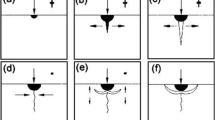Abstract
Among the alternatives to reduce the application of cutting fluid in machining industry, minimum quantity lubrication (MQL) technique has been promising, although it can impair cooling properties and the ability of the fluid to penetrate the cutting region. In order to further reduce the quantity of oil and to improve the characteristics of the cooling lubrication method, this work aims to compare the effect of MQL with different ratios of oil/water (1:1, 1:3, and 1:5) on the performance of plunge cylindrical grinding of alumina. Lubricating effect and effective penetration of fluid in the cutting zone are considered the most relevant factors. The lowest surface roughness value was obtained with the application of conventional flood cooling, followed by MQL 1:1. In comparison to conventional MQL technique, reduced surface roughness and grinding wheel wear could be obtained by applying MQL with water.
Similar content being viewed by others
References
Tanovic L, Bojanic P, Popovic M, Belic Z, Trifkovic S (2012) Mechanisms in oxide-carbide ceramic BOK 60 grinding. Int J Adv Manuf Technol 58:985–989
Denkena B, Busemann S, Gottwik L, Grove T, Wippermann A (2017) Material removal mechanisms in grinding of mixed oxide ceramics. Proc CIRP 65:70–77
Huang H, Liu YC (2003) Experimental investigations of machining characteristics and removal mechanisms of advanced ceramics in high speed deep grinding. Int J Mach Tools Manuf 43:811–823
Inasaki I (1987) Grinding of hard and brittle materials. CIRP Ann 36:463–471
Ramesh K, Yeo SH, Gowri S, Zhou L (2001) Experimental evaluation of super high-speed grinding of advanced ceramics. Int J Adv Manuf Technol 17:87–92
Zhang B, Zheng XL, Tokura H, Yoshikawa M (2003) Grinding induced damage in ceramics. J Mater Process Technol 132:353–364
Zhang B, Howes TD (1994) Material-removal mechanisms in grinding ceramics. CIRP Ann 43:305–308
Kuzin VV, Fedorov SY (2016) Roughness of high hardness ceramic correlation of diamond grinding regimes with Al2O3-ceramic surface condition. Refract Ind Ceram 57:65–70
Kuzin VV, Fedorov SY, Seleznev AE (2016) Effect of conditions of diamond grinding on tribological behavior of alumina-based ceramics. J Frict Wear 37:371–376
Liao TW, Li K, McSpadden SB Jr, O’Rourke LJ (1997) Wear of diamond wheels in creep-feed grinding ceramic materials—I. Mechanisms Wear 211:94–103
Liao TW, Li K, McSpadden SB Jr (2000) Wear mechanisms of diamond abrasives during transition and steady stages in creep-feed grinding of structural ceramics. Wear 242:28–37
Li W, Wang Y, Fan S, Xu J (2007) Wear of diamond grinding wheels and material removal rate of silicon nitrides under different machining conditions. Mater Lett 61:54–58
Sadeghi MH, Hadad MJ, Tawakoli T, Emami M (2009) Minimal quantity lubrication-MQL in grinding of Ti-6Al-4V titanium alloy. Int J Adv Manuf Technol 44:487–500
Tawakoli T, Hadad MJ, Sadeghi MH, Daneshi A, Stöckert S, Rasifard A (2009) An experimental investigation of the effects of workpiece and grinding parameters on minimum quantity lubrication. Int J Mach Tools Manuf 49:924–932
Sadeghi MH, Hadad MJ, Tawakoli T, Vesali A, Emami M (2010) An investigation on surface grinding of AISI 4140 hardened steel using minimum quantity lubrication—MQL technique. Int J Mater Form 3:241–251
Tawakoli T, Hadad MJ, Sadeghi MH (2010) Influence of oil mist parameters on minimum quantity lubrication—MQL grinding process. Int J Mach Tools Manuf 50:521–531
Hadad MJ, Hadi M (2013) An investigation on surface grinding of hardened stainless steel S34700 and aluminum alloy AA6061 using minimum quantity of lubrication (MQL) technique. Int J Adv Manuf Technol 68:2145–2158
Hadad MJ, Tawakoli T, Sadeghi MH, Sadeghi B (2012) Temperature and energy partition in minimum quantity lubrication—MQL grinding process. Int J Mach Tools Manuf 54-55:10–17
Oliveira DJ, Guermandi LG, Bianchi EC, Diniz AE, Aguiar PR, Canarim RC (2012) Improving minimum quantity lubrication in CBN grinding using compressed air wheel cleaning. J Mater Process Technol 212:2559–2568
Bianchi EC, Rodriguez RL, Hildebrandt RA, Lopes JC, Mello HJ, Silva RB, Aguiar PR (2017) Plunge cylindrical grinding with the minimum quantity lubrication coolant technique assisted with wheel cleaning system. Int J Adv Manuf Technol 95:2907–2916. https://doi.org/10.1007/s00170-017-1396-5
Damasceno RF, Ruzzi RS, França TV, Mello HJ, Silva RB, Aguiar PR, Bianchi EC (2017) Performance evaluation of various cooling-lubrication techniques in grinding of hardened AISI 4340 steel with vitrified bonded CBN wheel. Int J Adv Manuf Technol 92:375–3806
Ruzzi RS, Belentani RM, Mello HJ, Canarim RC, D’addona DM, Diniz AE, Aguiar PR, Bianchi EC (2017) MQL with water in cylindrical plunge grinding of hardened steels using CBN wheels, with and without wheel cleaning by compressed air. Int J Adv Manuf Technol 90:329–338
Mao C, Tang X, Zou H, Zhou ZX, Yin W (2012) Experimental investigation of surface quality for minimum quantity oil–water lubrication grinding. Int J Adv Manuf Technol 59:93–100
Incropera FP, Dewitt DP (2002) Fundamentals of heat and mass transfer. John Wiley & Sons, New York
Malkin S, Guo C (2008) Grinding technology: theory and applications of machining with abrasives. Industrial Press, New York
Acknowledgements
The authors would like to thank the Mechanical Engineering Department of the Faculty of Engineering of UNESP Bauru, the São Paulo Research Foundation (FAPESP) for financial support (grant numbers 2015/09197-7, 2015/09868-9, and 2017/03788-9), Dinser Ferramentas Diamantadas for the donation of the diamond grinding wheel, Máquinas Agrícolas Jacto S/A for the donation of the workpieces, and ITW Chemical Products Ltda. for the donation of the cutting fluids.
Author information
Authors and Affiliations
Corresponding author
Rights and permissions
About this article
Cite this article
Lopes, J.C., Ventura, C.E.H., Rodriguez, R.L. et al. Application of minimum quantity lubrication with addition of water in the grinding of alumina. Int J Adv Manuf Technol 97, 1951–1959 (2018). https://doi.org/10.1007/s00170-018-2085-8
Received:
Accepted:
Published:
Issue Date:
DOI: https://doi.org/10.1007/s00170-018-2085-8



